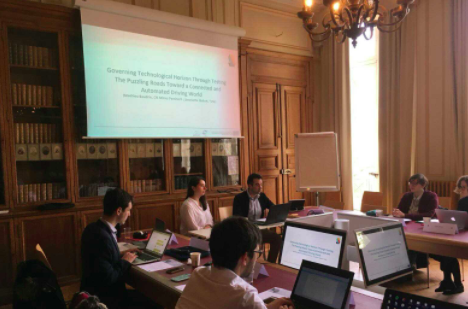By Mathieu Baudrin and Brice Laurent
The following is an adapted excerpt from the summary document of the workshop, “Putting Connected and Autonomous Vehicles to Test” which took place on 11 March, 2020 at Mines Paristech.

Connected and Autonomous Vehicles (CAV) are often presented as a major new field of innovation, if not a component of the “fourth industrial revolution”. At the European and national scales, more and more CAV projects are conducted through and by testing, and numerous policy and industrial initiatives use testing practices. These initiatives all share an objective of innovation and co-creation. They also vary depending on the actors involved, and the modalities and outcomes of tests. The diversity of innovation initiatives in the development of CAV invites us to explore testing practices and their expected outcomes.
On 11 March, 2020, experts from Austria, Germany, United-Kingdom, Switzerland and France came together in Paris to participate in the SCALINGS workshop “Putting Connected and Autonomous Vehicles to Test”. The workshop provided a platform to discuss preliminary insights from the SCALINGS project, to reflect on current challenges, and to share experiences and lessons learned in various European countries. The workshop focused on testbeds. Testbeds are co-creation instruments that have been used in CAV projects. The following aspects of testbeds were particularly discussed:
• Testbeds as public policy instruments
• Testbeds as models of wider realities
• Testbeds as places where public space is transformed
For each of these topics, the workshop identified a series of questions that actors involved in CAV projects in test-beds ought to ask, and put in discussion with the actors involved in co-creation.
Testbeds as public policy instruments
In France with the EVRA project, in Austria with DIGIBUS, or in Germany with Testfeld Autonomes Fahren Baden-Württemberg, testbeds are used by national and local governments to explore the possibilities of Connected and Autonomous Driving (CAD) technologies. This policy instrument is at the crossroads of different policy agendas related to Transport, Industry and Territorial development. Testbeds might offer ways of coordinating public and private stakeholders around technological projects.
Key questions:
- How to envision the common good as a possible outcome of coordinated experiments within test-beds?
- How to evaluate the socio-economic impacts of experiments?
- How to articulate the potentially conflicting priorities of different policy programs (e.g. industrial vs. transport policies)?
Testbeds as models of wider realities
The actors involved in testing attempt to simulate real conditions to put their technologies and their transport models to test. They do so in various ways, which result in various definitions of these “real conditions”. For instance, Transpolis, a testbed in France, proposes to reproduce real situations of use in a closed environment, Testfeld Autonomes Fahren Baden-Württemberg (TAF BW) (re)designs and equips existing public space in order to conduct tests in an open environment. The Heathrow Pods example in the United Kingdom is also interesting in this regard since the initial airport project has been extended to other places with different conditions of use.
Key questions:
- How to model situations of use (instead of technologies)? How to model users?
- Why is diversity important? How do you measure diversity?
- Can testing approaches circulate across Europe?
- How to shift from a problem of representing reality to an objective of crafting shared projects?
Test-beds as places where public space is transformed
In many ways, test beds and the current CAD development intend to modify the environment where they will be operated. The adjustment of physical spaces for testing comprises the equipment of infrastructures with sensors, the modification of public roads, and/or the construction of new ones. These modifications are required to turn a place into a usable laboratory. They are often necessary conditions to and ensure the safety of users during experiments. The physical transformation of public space is often accompanied with legal ones, as legal exceptions may be required to turn a zone into a testing ground. Eventually, using public space for testing also means involving the public in one way or another. Tests can be conducted in public, so that future users can observe potential technological developments. In many cases, prospective users are directly involved, in more or less active ways, in the conducts of tests.
Key questions:
- What/who is included/excluded in the transformation of public space into testing grounds?
- How are legal exceptions drawn?
- What is the timeframe of transformations? Are they supposed to last?